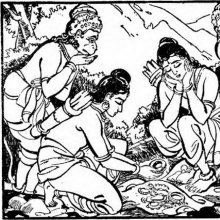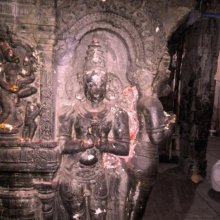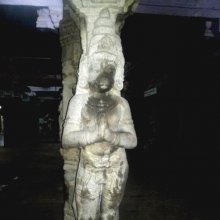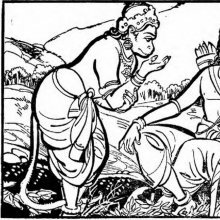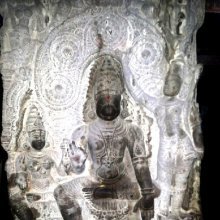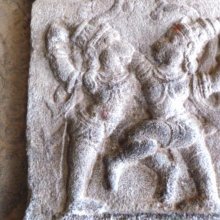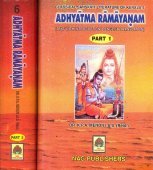Sugriva, Sugrīva: 29 definitions
Introduction:
Sugriva means something in Buddhism, Pali, Hinduism, Sanskrit, Jainism, Prakrit, Marathi. If you want to know the exact meaning, history, etymology or English translation of this term then check out the descriptions on this page. Add your comment or reference to a book if you want to contribute to this summary article.
Images (photo gallery)
(+8 more images available)
In Hinduism
Purana and Itihasa (epic history)
Source: archive.org: Puranic Encyclopedia1) Sugrīva (सुग्रीव).—Bāli and Sugrīva were brothers. Their mother was Aruṇa who once put the guise of a woman. At that time he was called by the name Aruṇī. Bāli was the son born to Indra by Aruṇī and Sugrīva was the son born to the Sun by Aruṇī. Both of them were brought up in the hermitage of Gautama. When the King of Kiṣkindhā Ṛkṣarajas died, Bāli was anointed the king of Kiṣkindhā. Sugrīva lived with Bāli, serving him. At this time Bāli engaged in a battle with the asura Dundubhi. Bāli chased Dundubhi into a cave. Placing Sugrīva at the mouth of the cave, Bāli went in. By the magic and sorcery of Dundubhi, it appeared to Sugrīva that Bāli was killed by Dundubhi. Sugrīva returned to Kiṣkindhā. Bāli who came out, followed Sugrīva to kill him due to misunderstanding. Bāli chased Sugrīva all over the world. It is mentioned in Vālmīki Rāmāyaṇa, Kiṣkindhā Kāṇḍa, Sarga 46, that the knowledge of the lay-out of the various countries in the world that Sugrīva got in this running, helped him later, in the search for Sītā.
At last Sugrīva entered Ṛṣyamūkācala. Bāli had been once cursed that if he entered this mountain his head would be broken into pieces. Hanūmān became the minister of Sugrīva. It was during this period that Śrī Rāma and Lakṣmaṇa came by that way in search of Sītā. Sugrīva and Śrī Rāma entered into a treaty. Bāli should be killed and Kiṣkindhā should be given to Sugrīva in place of which Rāma should be helped to find out Sītā and get her back. (See full article at Story of Sugrīva from the Puranic encyclopaedia by Vettam Mani)
2) Sugrīva (सुग्रीव).—An asura. This asura was the minister of Śumbha, an asura-chief. (Devī Bhāgavata).
3) Sugrīva (सुग्रीव).—A horse of Śrī Kṛṣṇa. It is mentioned in Mahābhārata, Droṇa Parva, Chapter 147, Verse 47, that five horses Kāmaga, Śaibya, Sugrīva, Meghapuṣpa and Valāhaka were yoked to the chariot of Śrī Kṛṣṇa.
Source: Cologne Digital Sanskrit Dictionaries: The Purana Index1a) Sugrīva (सुग्रीव).—A friend of Rāma. Dvivida was one of his ministers. Helped Rāma in his expedition to Lankā. Held the chauri when Bharata carried the Pādukā. Attained salvation by satsanga;1 the son of Viraja and Sūrya: Rumā was his queen: younger brother of Vāli;2 present at Rāma's abhiṣeka;3 to be worshipped before commencing the construction of a palace.4
- 1) Bhāgavata-purāṇa IX. 10. 16, 19 & 43; X. 67. 2; XI. 12. 6.
- 2) Brahmāṇḍa-purāṇa III. 7. 215, 220 & 70.
- 3) Viṣṇu-purāṇa IV. 4. 100.
- 4) Matsya-purāṇa 268. 15
1b) The name of a horse of the chariot of Kṛṣṇa.*
- * Bhāgavata-purāṇa X. 53. 5; 70. 14; 89. 49.
1c) A son of Śrutadevī and Kṛta.*
- * Matsya-purāṇa 46. 5.
1d) The name of a son of Garuḍa on the Vaikanka hill.*
- * Vāyu-purāṇa 39. 40.
1e) A king of Kinnaras; a gaṇa, all of them horse-faced, and going after his name*
- * Vāyu-purāṇa 41. 30; 69. 32.
Sugrīva (सुग्रीव).—Vālin and Sugrīva were the two sons of Ahalyā, wife of Gautama ṛṣi. Without the knowledge of her ascetic husband, she conceived secretly and gave birth to two sons, Vālin the elder by Indra and Sugrīva the younger by Sūrya.
Source: Shodhganga: The saurapurana - a critical studySugrīva (सुग्रीव) is the king of king of the Monkeys and friend of Rāma, according to the Vaṃśānucarita section of the 10th century Saurapurāṇa: one of the various Upapurāṇas depicting Śaivism.—Accordingly, [...] Demon Rāvaṇa abducted Sītā from the forest and took her to Laṃka. Being unhappy both the brothers while roaming in the forest made friendship with Sugrīva the king of the Monkeys. Hanumān went to Laṃka and saw Sītā and in order to believe him as the attendant of Rāma, he gave her the ring of Śrīrāma.

The Purana (पुराण, purāṇas) refers to Sanskrit literature preserving ancient India’s vast cultural history, including historical legends, religious ceremonies, various arts and sciences. The eighteen mahapuranas total over 400,000 shlokas (metrical couplets) and date to at least several centuries BCE.
Vastushastra (architecture)
Source: Wisdom Library: Vāstu-śāstraSugrīva (सुग्रीव) refers to a variety of maṇḍapa (halls attached to the temple), according to the Matsya-purāṇa (verses 270.1-30). The sugrīva-maṇḍapa is to be built with 24 pillars (stambha). The Matsyapurāṇa is one of the eighteen major purāṇas dating from the 1st-millennium BCE.
Accordingly (verse 270.15-17), “These maṇḍapas (e.g., sugrīva) should be either made triangular, circular, octagonal or with 16 sides or they are square. They promote kingdoms, victory, longevity, sons, wife and nourishment respecitvely. Temples of other shape than these are inauspicious.”
Source: Brill: Śaivism and the Tantric Traditions (architecture)Sugrīva (सुग्रीव) refers to one of the deities to be installed in the ground plan for the construction of houses, according to the Bṛhatkālottara, chapter 112 (the vāstuyāga-paṭala).—The plan for the construction is always in the form of a square. That square is divided into a grid of cells (padas). [...] Once these padas have been laid out, deities [e.g., Sugrīva] are installed in them. In the most common pattern 45 deities are installed.
Sugrīva as a doorway deity is associated with the Nakṣatra called Pūrvāṣāḍhā and the consequence is kṛṣisaukhya. [...] The Mayasaṃgraha (verse 5.156-187) describes a design for a 9-by-9-part pura, a residential complex for a community and its lead figure. [...] This record lists a place for food storage at Sugrīva, Puṣpadanta and Pracetas.

Vastushastra (वास्तुशास्त्र, vāstuśāstra) refers to the ancient Indian science (shastra) of architecture (vastu), dealing with topics such architecture, sculpture, town-building, fort building and various other constructions. Vastu also deals with the philosophy of the architectural relation with the cosmic universe.
Shaktism (Shakta philosophy)
Source: Wisdom Library: ŚāktismSugrīva (सुग्रीव) refers to one of the 53 gods to be worshipped in the western quarter and given pāyasa (rice boiled in milk) according to the Vāstuyāga rite in Śaktism (cf. Śāradātilaka-tantra III-V). The worship of these 53 gods happens after assigning them to one of the 64 compartment while constructing a Balimaṇḍapa. Vāstu is the name of a prodigious demon, who was killed by 53 gods (e.g., Sugrīva).
Source: Google Books: ManthanabhairavatantramSugrīva (सुग्रीव) refers to one of the eight Guardians (kṣetrapāla-aṣṭaka) associated with Candrapīṭha (or Candrapīṭhapura), according to the Manthānabhairavatantra, a vast sprawling work that belongs to a corpus of Tantric texts concerned with the worship of the goddess Kubjikā.—[...] The eight Guardians (kṣetrapālāṣṭaka): Niśānta, Nigraha, Dhanañjaya, Dhaneśvara, Karāla, Vaḍavāmukha, Vikarāla, Sugrīva.
Source: Shodhganga: Iconographical representations of Śiva (shaktism)Sugrīva (सुग्रीव) or Sugrīvatantra refers to one of the twenty-eight Gāruḍatantras, belonging to the Śāktāgama (or Śāktatantra) division of the Āgama tradition. The Śāktāgamas represent the wisdom imparted by Devī to Īśvara and convey the idea that the worship of Śakti is the means to attain liberation. According to the Pratiṣṭhālakṣaṇasamuccaya of Vairocana, the Śāktatantras are divided into to four parts, the Sugrīva belonging to the Garuḍa class.

Shakta (शाक्त, śākta) or Shaktism (śāktism) represents a tradition of Hinduism where the Goddess (Devi) is revered and worshipped. Shakta literature includes a range of scriptures, including various Agamas and Tantras, although its roots may be traced back to the Vedas.
Kavya (poetry)
Source: Wisdom Library: KathāsaritsāgaraSugrīva (सुग्रीव) was a friend of Rāma, according to in the Kathāsaritsāgara, chapter 51. Accordingly, “... there Rāvaṇa carried off his beloved Sītā by magic, and took her to the city of Laṅkā, having slain Jaṭāyus on the way. Then Rāma, in his bereaved state, made Sugrīva his friend by killing Bālin, and by sending Hanumān to Laṅkā obtained news of his wife”.
The story of Sugrīva was narrated by the Vidyādharī Kāñcanaprabhā to Naravāhanadatta while in a Svayambhū temple of Śiva, in order to demonstrate that “people who possess firmness endure for a long time mutual separation to which no termination is assigned”, in other words, that “heroic souls endure separation for so long a time”.
The Kathāsaritsāgara (‘ocean of streams of story’), mentioning Sugrīva, is a famous Sanskrit epic story revolving around prince Naravāhanadatta and his quest to become the emperor of the vidyādharas (celestial beings). The work is said to have been an adaptation of Guṇāḍhya’s Bṛhatkathā consisting of 100,000 verses, which in turn is part of a larger work containing 700,000 verses.

Kavya (काव्य, kavya) refers to Sanskrit poetry, a popular ancient Indian tradition of literature. There have been many Sanskrit poets over the ages, hailing from ancient India and beyond. This topic includes mahakavya, or ‘epic poetry’ and natya, or ‘dramatic poetry’.
Vaishnavism (Vaishava dharma)
Source: Pure Bhakti: Brhad BhagavatamrtamSugrīva (सुग्रीव) refers to:—The monkey king in the Ṛṣya-mūka mountains who received Rāma and Lakṣmaṇa when they were searching for Sitā; the brother of Vāli. (cf. Glossary page from Śrī Bṛhad-bhāgavatāmṛta).

Vaishnava (वैष्णव, vaiṣṇava) or vaishnavism (vaiṣṇavism) represents a tradition of Hinduism worshipping Vishnu as the supreme Lord. Similar to the Shaktism and Shaivism traditions, Vaishnavism also developed as an individual movement, famous for its exposition of the dashavatara (‘ten avatars of Vishnu’).
General definition (in Hinduism)
Source: WikiPedia: Hinduism1) In the Hindu epic Ramayana, Sugriva was the younger brother of Vali, whom he succeeded as ruler of the vanara or monkey kingdom Kishkindha. Rumā was his wife. He was the son of Surya, the Hindu deity of the sun. As king of the monkeys, Sugriva aided Rama in his quest to liberate his wife Sita from captivity at the hands of the Rakshasa king Ravana.
2) Sugrīva (सुग्रीव): Monkey-king, friend of Sri Rama, and brother of mighty Vali whom Sri Rama killed.
etymology: Sugriva (Sanskrit: सुग्रीव Sugrīva; Malay and Javanese: Sugriwa; Thai: สุครีพ, RTGS: Su-khrip; Lao: Sugeep; Khmer: Sukhreeb; Creole: Soogrim; Lao: Sangkip; Tamil: Cukkirivan; Burmese: Thugyeik), also spelled Sugreeva or Sugreev
In Buddhism
Tibetan Buddhism (Vajrayana or tantric Buddhism)
Source: Wisdom Library: Tibetan BuddhismSugrīva (सुग्रीव) is the name of Vidyārāja (i.e., “wisdom king”) mentioned as attending the teachings in the 6th century Mañjuśrīmūlakalpa: one of the largest Kriyā Tantras devoted to Mañjuśrī (the Bodhisattva of wisdom) representing an encyclopedia of knowledge primarily concerned with ritualistic elements in Buddhism. The teachings in this text originate from Mañjuśrī and were taught to and by Buddha Śākyamuni in the presence of a large audience (including Sugrīva).

Tibetan Buddhism includes schools such as Nyingma, Kadampa, Kagyu and Gelug. Their primary canon of literature is divided in two broad categories: The Kangyur, which consists of Buddha’s words, and the Tengyur, which includes commentaries from various sources. Esotericism and tantra techniques (vajrayāna) are collected indepently.
Mahayana (major branch of Buddhism)
Source: archive.org: Bulletin of the French School of the Far East (volume 5)Sugrīva (सुग्रीव) [?] is the name of a Gandharva appointed as one of the Divine protector deities of Śūlīka, according to chapter 17 of the Candragarbha: the 55th section of the Mahāsaṃnipāta-sūtra, a large compilation of Sūtras (texts) in Mahāyāna Buddhism partly available in Sanskrit, Tibetan and Chinese.—In the Candragarbhasūtra, the Bhagavat invites all classes of Gods and Deities to protect the Law [dharma?] and the faithful in their respective kingdoms of Jambudvīpa [e.g., the Gandharva Sugrīva in Śūlīka], resembling the time of the past Buddhas.

Mahayana (महायान, mahāyāna) is a major branch of Buddhism focusing on the path of a Bodhisattva (spiritual aspirants/ enlightened beings). Extant literature is vast and primarely composed in the Sanskrit language. There are many sūtras of which some of the earliest are the various Prajñāpāramitā sūtras.
In Jainism
General definition (in Jainism)
Source: Wisdom Library: JainismSugrīva (सुग्रीव) is the father of Puṣpadanta, the ninth of twenty-four Tīrthaṅkaras in Janism according to the Ācāradinakara (14th century work on Jain conduct written by Vardhamāna Sūri). A Tīrthaṅkara is an enlightened being who has conquered saṃsāra (cycle of birth and death), leaving behind him a path for others to follow.
The wife of Sugrīva is Rāmā. It is an ancient Jain practice to worship the Tīrthaṅkara’s parents in various rites, such as the pratiṣṭhāvidhi.
Source: archive.org: Een Kritische Studie Van Svayambhūdeva’s PaümacariuSugrīva (सुग्रीव) participated in the war between Rāma and Rāvaṇa, on the side of the latter, as mentioned in Svayambhūdeva’s Paumacariu (Padmacarita, Paumacariya or Rāmāyaṇapurāṇa) chapter 57ff. Svayambhū or Svayambhūdeva (8th or 9th century) was a Jain householder who probably lived in Karnataka. His work recounts the popular Rāma story as known from the older work Rāmāyaṇa (written by Vālmīki). Various chapters [mentioning Sugrīva] are dedicated to the humongous battle whose armies (known as akṣauhiṇīs) consisted of millions of soldiers, horses and elephants, etc.
Source: archive.org: The Jaina IconographySugrīva (सुग्रीव) is the father of Suvidhinātha: the ninth of twenty-four Tīrthaṃkaras or Jinas.—From patriarchical history, we gather [Suvidhinātha’s] native place was called Kākandīnagara. His father was the ruling prince by the name of Sugrīva and his mother was named Rāmā, his place of Nirvāṇa was Sameta-Śikhara or Mount Pārasnātha. His father was the lord of Kākandī. Curiously, Kākandī is called Kākandīnagara (Sanskrit: Kiṣkindhānagara). Let us remember, his father is called Sugrīva, his mother has the name of Rāmā. All this has curious association with the Rāmāyaṇa. The Kiṣkindha of the Rāmāyaṇa was situated on the sea. Hence, it is evident that aquatic animals like a crocodile or a crab have come to be the emblems of this Tīrthaṃkara.
Source: archive.org: Trisastisalakapurusacaritra1) Sugrīva (सुग्रीव) is the name of an ancient king from Kākandī and father of Suvidhinātha, according to chapter 3.7 [suvidhinātha-caritra] of Hemacandra’s 11th century Triṣaṣṭiśalākāpuruṣacaritra: an ancient Sanskrit epic poem narrating the history and legends of sixty-three illustrious persons in Jainism.
Accordingly, “Now, in the southern half of Bharata in this Jambūdvīpa there is a very important city Kākandī distinguished by its wealth. [...] The king was named Sugrīva, like a necklace of the earth, like a Graiveyaka-god in beauty. His command, like a weapon with an efficacious charm, was nowhere cast aside, neither in cities, forests, oceans, nor mountains. The river of wise policy with high-crested water of glory rose in him like a mountain and flowed to the ocean. The ocean of glorious deeds of him, the crest-jewel of kings, devoured the wide streams of glory of all the kings. [...]”.
2) Sugrīva (सुग्रीव) refers to one of the sons of Ādityarajas and Indumālinī, according to the Jain Ramayana and chapter 7.2 [Rāvaṇa’s expedition of conquest].—Accordingly, “Now, a son was borne to Ādityarajas, the king of the Kapis, by his chief-queen Indumālinī, named Vālin, powerful. Vālin, abundantly endowed with strength of arm, constantly circumambulating Jambūdvīpa bounded by the ocean, paid homage to all the shrines. There was another son of Ādityarajas, Sugrīva, and a younger daughter, Suprabhā. [....] King Ādityarajas gave his kingdom to Vālin, powerful, became a mendicant, and reached emancipation, after practicing penance. Vālin made Sugrīva heir-apparent, who possessed right-belief, knew the law, was compassionate, powerful, like himself”.

Jainism is an Indian religion of Dharma whose doctrine revolves around harmlessness (ahimsa) towards every living being. The two major branches (Digambara and Svetambara) of Jainism stimulate self-control (or, shramana, ‘self-reliance’) and spiritual development through a path of peace for the soul to progess to the ultimate goal.
Languages of India and abroad
Marathi-English dictionary
Source: DDSA: The Molesworth Marathi and English Dictionarysugrīva (सुग्रीव).—m (S) The name of the monkey-king, the friend and confederate of Ramachandra in his war against Rawan̤. 2 Attributively. (su & grīvā) Handsome-necked.
Source: DDSA: The Aryabhusan school dictionary, Marathi-Englishsugrīva (सुग्रीव).—m The monkey-king friend of Ramchandra. a Handsome-necked.
Marathi is an Indo-European language having over 70 million native speakers people in (predominantly) Maharashtra India. Marathi, like many other Indo-Aryan languages, evolved from early forms of Prakrit, which itself is a subset of Sanskrit, one of the most ancient languages of the world.
Sanskrit dictionary
Source: DDSA: The practical Sanskrit-English dictionarySugrīva (सुग्रीव).—a. having a beautiful neck. (-vaḥ) 1 a hero.
2) a swan.
3) a kind of weapon.
4) Name of one of the four horses of Kṛṣṇa.
5) of Śiva.
6) of Indra.
7) Name of a monkey-chief and brother of Vāli. [By the advice of Kabandha, Rāma went to Sugrīva who told him how his brother had treated him and besought his assistance in recovering his wife, promising at the same time that he would assist Rāma in recovering his wife Sīta. Rāma, therfore, killed vāli, and installed Sugrīva on the throne. He then assisted Rāma with his hosts of monkeys in conquering Rāvaṇa, and recovering Sīta.] °ईशः (īśaḥ) Name of Rāma; सुग्रीवेशः कटी पातु (sugrīveśaḥ kaṭī pātu) Rāma-rakṣā.8.
Sugrīva is a Sanskrit compound consisting of the terms su and grīva (ग्रीव).
Source: Cologne Digital Sanskrit Dictionaries: Edgerton Buddhist Hybrid Sanskrit DictionarySugrīva (सुग्रीव).—(1) name of a future Buddha: Mahāvastu iii.330.11; (2) m., name of a mountain in the south: Gaṇḍavyūha 58.17; 59.7 etc.
Source: Cologne Digital Sanskrit Dictionaries: Shabda-Sagara Sanskrit-English DictionarySugrīva (सुग्रीव).—mfn.
(-vaḥ-vā-vaṃ) Handsome-necked. m.
(-vaḥ) 1. One of the horses of of Krishna'S car. 2. A monkey-king, the son of the sun, and sovereign of Kishkindhya, and friend and confederate of Rama Chandra. 3. The father of the ninth Jina of the present age. 4. Siva. 5. Indra. 6. A goose. 7. A hero. 8. A piece of water. 9. The name of a mountain. 10. A sort of weapon. 11. The countenance of a friend. 12. A serpent of Patala. E. su handsome, and grīvā a neck.
Source: Cologne Digital Sanskrit Dictionaries: Benfey Sanskrit-English DictionarySugrīvā (सुग्रीवा).—I. adj. handsome-necked. Ii. m. 1. a goose. 2. a hero. 3. a sort of weapon. 4. one of Kṛṣṇa’s horses. 5. a proper name. 6. Indra. 7. Śiva. 8. a serpent of the lower regions. 9. the name of a mountain.
Sugrīvā is a Sanskrit compound consisting of the terms su and grīvā (ग्रीवा).
Source: Cologne Digital Sanskrit Dictionaries: Cappeller Sanskrit-English DictionarySugrīva (सुग्रीव).—[masculine] ī [feminine] a man’s or woman’s name ([mythological]).
Source: Cologne Digital Sanskrit Dictionaries: Monier-Williams Sanskrit-English Dictionary1) Sugrīva (सुग्रीव):—[=su-grīva] [from su > su-ga] mfn. handsome-necked, having a beautiful neck
2) [v.s. ...] m. (ifc. f(ā). ) Name of a monkey-king (who, with his army of monkeys headed by Hanumat, assisted Rāmacandra in conquering Rāvaṇa; he was believed to be the son of the Sun, and was re-established by Rāma in the throne of Kiṣkindha q.v., usurped by his brother Vālin), [Mahābhārata; Rāmāyaṇa] etc.
3) [v.s. ...] m. of one of the four horses of Kṛṣṇa or Viṣṇu (the other three being Balāhaka, Megha-puṣpa, and Śaivya), [Mahābhārata; Harivaṃśa; Bhāgavata-purāṇa]
4) [v.s. ...] of a divine being, [Varāha-mihira’s Bṛhat-saṃhitā]
5) [v.s. ...] of the father of the ninth Arhat of the present Avasarpiṇī, [cf. Lexicographers, esp. such as amarasiṃha, halāyudha, hemacandra, etc.]
6) [v.s. ...] a kind of pavilion, [Vāstuvidyā]
7) [v.s. ...] (only [cf. Lexicographers, esp. such as amarasiṃha, halāyudha, hemacandra, etc.]) a conch
8) [v.s. ...] Name of Śiva or Indra
9) [v.s. ...] a goose
10) [v.s. ...] a hero
11) [v.s. ...] a piece of water
12) [v.s. ...] Name of a mountain
13) [v.s. ...] a sort of weapon
14) [v.s. ...] the countenance of a friend
15) [v.s. ...] a serpent of Pātāla, [Horace H. Wilson]
16) [v.s. ...] f(ā or ī). Name of an Apsaras, [Harivaṃśa]
Source: Cologne Digital Sanskrit Dictionaries: Yates Sanskrit-English DictionarySugrīva (सुग्रीव):—[(vaḥ-vā-vaṃ) m.] Horse of Krishna's car; a monkey king and ally of Rāma; Shiva; Indra; name of a number of objects having a handsome neck. a. Handsomenecked.
Source: DDSA: Paia-sadda-mahannavo; a comprehensive Prakrit Hindi dictionary (S)Sugrīva (सुग्रीव) in the Sanskrit language is related to the Prakrit word: Suggīva.
[Sanskrit to German]
Sanskrit, also spelled संस्कृतम् (saṃskṛtam), is an ancient language of India commonly seen as the grandmother of the Indo-European language family (even English!). Closely allied with Prakrit and Pali, Sanskrit is more exhaustive in both grammar and terms and has the most extensive collection of literature in the world, greatly surpassing its sister-languages Greek and Latin.
See also (Relevant definitions)
Starts with: Sugrivagraja, Sugrivajne, Sugrivatantra, Sukrivan.
Ends with: Nihsugriva.
Full-text (+198): Ramasakha, Ruma, Vanarendra, Adityasunu, Kapindra, Suryaja, Ravinandana, Ravisuta, Kapishvara, Vali, Sushena, Suryatanaya, Rishyamuka, Madhuvana, Riksharajas, Rikshaharishvara, Kishkindha, Arkaja, Rishyamuk, Shauri.
Relevant text
Search found 58 books and stories containing Sugriva, Sugrīva, Sugrīvā; (plurals include: Sugrivas, Sugrīvas, Sugrīvās). You can also click to the full overview containing English textual excerpts. Below are direct links for the most relevant articles:
Sahitya-kaumudi by Baladeva Vidyabhushana (by Gaurapada Dāsa)
Text 7.26 < [Chapter 7 - Literary Faults]
Hanuman Nataka (critical study) (by Nurima Yeasmin)
9.15. The characters of Vālī and Sugrīva < [Chapter 4]
Source of the Plot < [Chapter 3]
9.17. The character of Hanumān < [Chapter 4]
Trishashti Shalaka Purusha Caritra (by Helen M. Johnson)
Part 8: Fate of Bhadrā < [Chapter I - Previous incarnations of Ariṣṭanemi (Nemi)]
Part 2: Sāhasagati as a false Sugrīva < [Chapter VI - Bringing news of Sītā]
Part 9: Marriage with Gandharvaṣenā, daughter of Cārudatta < [Chapter II - Marriages of Vasudeva with maidens]
Ramayana of Valmiki (by Hari Prasad Shastri)
Chapter 35 - Tara defends Sugriva < [Book 4 - Kishkindha-kanda]
Chapter 5 - The Alliance of Rama and Sugriva < [Book 4 - Kishkindha-kanda]
Chapter 97 - The Fight between Virupaksha and Sugriva < [Book 6 - Yuddha-kanda]
Animal Kingdom (Tiryak) in Epics (by Saranya P.S)
Chapter 3.8 - The story of Bali (Monkey characters, part 2)
Chapter 3.15 - The story of Ruma (Women characters, part 2)
Puranic encyclopaedia (by Vettam Mani)
Related products
